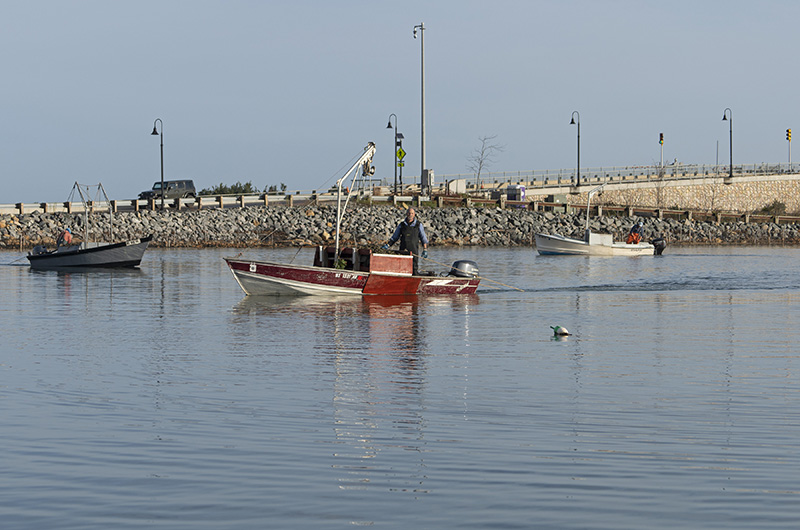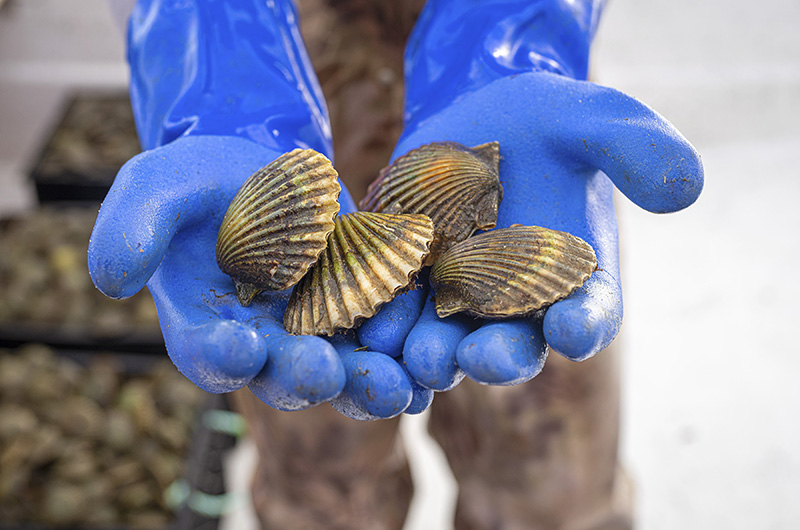Bay scallop season has arrived, and while most of the Island is reporting an average or down year on the ponds, there is cautious excitement in Tisbury, where fishermen are pulling up a bumper crop of scallops in the Lagoon Pond.
Last year, Tisbury harvested just 14 bushels of scallops before shellfish constable Danielle Ewart closed the Lagoon. One year later, when the Lagoon opened to recreational fishermen on a beautiful morning this past Saturday, scallopers brought in approximately three times that amount in a single day.

“It’s going quite well, actually,” Ms. Ewart said. “On opening day we had 65 bushels harvested. It’s not our record, which is around 80, but it’s pretty good. Last year’s was pretty dismal because we had a lot of seed. But it looks like the seed from last year are adults this year.”
Commercial scalloping in Tisbury opened on Monday, with 19 draggers and one dip netter out on the Lagoon.
Scallops have a cyclical, approximately two-year lifespan, spawning during early summer and traditionally found in and around the Island’s saltwater ponds. Although they were plentiful in years past, with fishermen often capable of filling their quotas in a single drag or two, a variety of factors, including increased development, declining water quality and the disappearance of eelgrass, have caused a steep drop in recent years.
But the unique biology of bay scallops means the population can have boom-and-bust cycles, with a bad year often portending a good one. Last year, Ms. Ewart noticed that scallopers were pulling up a large amount of seed, a term for scallops that are too small to be commercially or recreationally harvested. The constable had a tough decision to make — keep the Lagoon open so fishermen who depend on the shellfish for their livelihood have a chance to collect their quotas, or close it and hope for the best next year.
Ms. Ewart decided to close the pond. The decision appears to be paying off.
“I feel like it was the right decision,” Ms. Ewart said this week. “I was going to do it regardless of the pushback, because you have to respect the pond. You see what’s going on, but then you make the decision. There might have been some pushback, but then a lot of people were thanking me for doing it this year. A lot of happy dipnetters this year.”
Over in Edgartown, shellfish constable Paul Bagnall said the picture wasn’t as rosy — although Cape Pogue Pond still accounts for about 65 per cent of the Island’s scallop yield annually. He said Cape Pogue has had about 25 draggers on it since it opened for commercial scalloping earlier this week, and most were reaching their three-bushel limit by midday.

Edgartown has issued 60 commercial licenses to scallopers year.
“The good news is we have scallops,” Mr. Bagnall said. “The bad news is we don’t have a lot of them.”
Mr. Bagnall said today a good year can range anywhere between 5,000 and 8,000 bushels. In 2018, which he called a banner year, the town brought in 10,000. In the 1960s and 1970s, the yield was generally around 20,000 to 25,000, with 150 boats on the water.
“It’s kind of couched in modern era of what’s a good year,” the longtime constable said, “We catch less, but there’s fewer fishermen. I don’t know if that’s a good thing.”
Mr. Bagnall said he is increasingly concerned about the decline in eelgrass in the pond, and a variety of factors could have affected the low scallop population over the past two years.
“They like lot a hot, dry June, and we definitely didn’t have that this year,” Mr. Bagnall said.
He discussed how rainfall can affect the crop, pushing the scallops to the bottom of the pond and preventing them from swimming during their veliger phase. With thin eelgrass cover, that makes the scallops vulnerable to predation, Mr. Bagnall said.
“It’s a down year for us,” Mr. Bagnall said. “But I only have a [bachelor’s degree] from UMass . . . my Ph.D. is from Edgartown.”
In Oak Bluffs, first-year constable Chuck Fisher said the town was having an average year as well, with some scallopers able to fill their quota and others not.
At a meeting in Chilmark this week, selectmen voted to hold off on opening the commercial bay scallop season until Dec. 1 after constable Isaiah Scheffer said he had found a lot of nub, or seed scallops with a growth ring, in his net.
“When I went out to the flats, the best towing I had in one drag was four scallops,” Mr. Scheffer told selectmen.
The mood was different in Tisbury last week, with shellfishermen all smiles. While all the towns have a strong relationship with the nonprofit Martha’s Vineyard Shellfish Group, which produces shellfish seed for the entire Island, the Lagoon plays host to two of its hatcheries — the Hughes hatchery (formerly the state lobster hatchery) and the solar hatchery at the head of the pond. Amandine Surier Hall, who runs the group, said this was a particularly good year for seed production.
“The Lagoon is really important to us,” Ms. Surier Hall said. “This year we produced a lot of scallops, more than we have in the past.”
She added that one of the only places that the group saw significant spawning from natural seed was the Lagoon, despite environmental factors that she believes have caused the Lagoon to struggle in years past. Those factors include bridge construction and algae blooms.
“Scallops are what we do all summer long,” Ms. Surier Hall said. “It was really fun to see the fruits of our labor coming out of the water on Saturday. We were a little anxious because shellfish stocks pop up and down all the time, and every good year we hope it is like that forever, and every bad year we worry that it will be like that forever. But this year was breathing a sigh of relief.”
According to Ms. Surier Hall, 2018 was the worst year since the town began keeping records in the 1970s.
Although Ms. Ewart was cautious about calling 2019 a banner year, she said she was hopeful scallopers wouldn’t have to deal with another early closing. She said that days two and three and four on the water saw 61, 60, and 58 bushels respectively, showing that the numbers are steady.
“I’m not going to say it’s a great year, I’m just going to say it’s an okay year, because I don’t know how long it will last,” Ms. Ewart said. “Scallops are very sensitive creatures, that’s why it’s hard to predict sometimes. You can see a lot of adults in one month, and then something catastrophic can happen.”
She continued:
“But yeah, everything seems to be pretty good right now.”








Comments (5)
Comments
Comment policy »